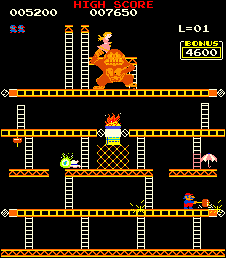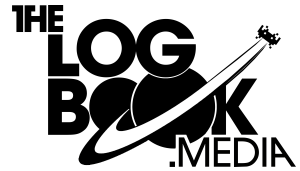 The Game: An oversized gorilla kidnaps the girlfriend of an unidentified plumber and hauls her up to the top of a building. You are that plumber who shall remain nameless, dodging
The Game: An oversized gorilla kidnaps the girlfriend of an unidentified plumber and hauls her up to the top of a building. You are that plumber who shall remain nameless, dodging Donkey Crazy Kong’s never-ending hail of rolling barrels and fireballs in your attempt to climb to the top of the building and topple Donkey Crazy Kong. This rescue operation is repeated in several settings: a screen of sloped girders, a cement factory with conveyor belts, a series of precarious platforms and elevators, and the top of the building, with rivets that can be removed to send Donkey Crazy Kong plummeting to the ground… and then the game begins again with the aforementioned girlfriend in captivity once more. (Falcon, 1981)
Memories: As was often the case in the early ’80s, when the video game business was a vast, unexplored frontier, there were legal boundaries waiting to be pushed – and quite a few that just didn’t exist yet. From the same mentality that brought about an exact duplicate of Scramble from another company, and brought you Piranha and Popeye Pac-Man, came a Donkey Kong dupe: Crazy Kong. But this was a case where everything was actually above-board.
 Put simply, Crazy Kong was Donkey Kong, with the order of levels mixed up a bit, the graphics and sounds messed with, and with Nintendo‘s name surgically removed from the product.
Put simply, Crazy Kong was Donkey Kong, with the order of levels mixed up a bit, the graphics and sounds messed with, and with Nintendo‘s name surgically removed from the product. Donkey Crazy Kong’s face was drawn a bit differently, but it wasn’t an expert graphics hack – it was easy to spot the seams. The music was removed from the game, and the sounds seemed randomly jumbled as if this would somehow make Crazy Kong a whole different animal. Mario The Plumber Who Shall Not Be Named made a sound, when jumping, like a squeeze toy being run over.
Falcon was actually a legitimate licensee of Nintendo, with permission to sell Crazy Kong machines to non-U.S. markets, but a great many Crazy Kong machines did show up in the U.S. In Fort Smith, Arkansas alone – not exactly a hotbed of arcade activity – I remember seeing Crazy Kong machines in two different locations. Legit licensee or not, Falcon was clearly selling this “version” of Donkey Kong to whoever wanted to pony up for it. Further clues to Falcon’s intentions were their other arcade games: Crazy Kong Junior, Jin and Silver Land, all copies of existing games. Court records indicate that Falcon’s license to produce Crazy Kong ended om January 29, 1982, barely a year after being issued – an unusually short life span for a contract if all parties involved were satisfied with the arrangement. (The case in question involves parties who illegally distributed Crazy Kong in the United States.)
 Ironically, one of the places here that had the machine also had numerous bootleg Pac-Man ripoffs – the aforementioned Piranha and Popeye Pac-Man.
Ironically, one of the places here that had the machine also had numerous bootleg Pac-Man ripoffs – the aforementioned Piranha and Popeye Pac-Man.
The game play is identical to Donkey Kong, so it’s hard to fault it in the fun department – it was just someone else’s fun repackaged. Crazy Kong also gave less adept Donkey Kong players their first glimpses of such levels as the cement factory and the elevators, which couldn’t be seen in Donkey Kong without advancing past the first building (unless an arcade operator had some really unusual DIP switch settings in play on his Donkey Kong cabinet).
